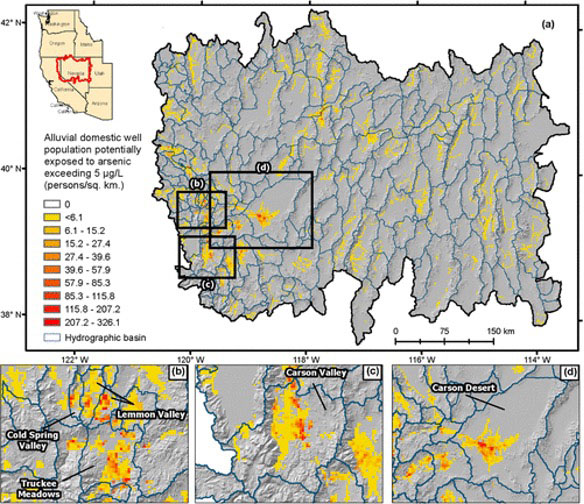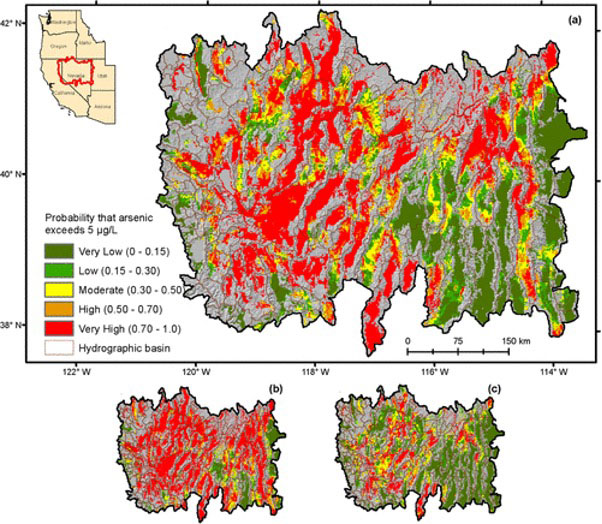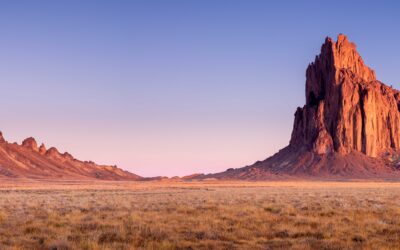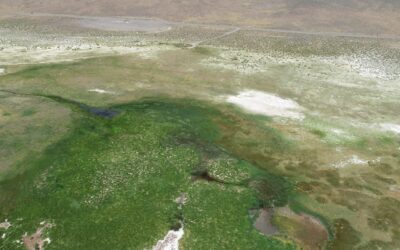A New Study Maps Risk of Elevated Arsenic Levels in Groundwater Wells Across Northern Nevada, Northeastern California, and Western Utah
In the arid and drought-stricken western Great Basin, sparse surface water means rural communities often rely on private groundwater wells. Unlike municipal water systems, well water quality in private wells is unregulated, and a new study shows that more than 49 thousand well users across the region may be at risk of exposure to unhealthy levels of arsenic in drinking water.
Led by researchers at DRI and the University of Hawai’i Cancer Center and published February 16th in Environmental Science and Technology, the study used data from groundwater wells across the western Great Basin to build a model to predict the probability of elevated arsenic in groundwater, and the location and number of private well users at risk. According to the study, the Carson Desert basin (including the town of Fallon, Nevada), Carson Valley (Minden and Gardnerville, Nevada), and the Truckee Meadows (Reno), have the highest population of well users at risk. The new study builds on previous research showing that 22% of 174 domestic wells sampled in Northern Nevada had arsenic levels exceeding the EPA guideline.
“What we are finding is that in our region, we have a high probability for elevated arsenic compared to most other regions in the country,” said Daniel Saftner, M.S., a hydrogeologist at DRI and lead author of the study. “And we are seeing that geothermal and tectonic processes that are characteristic of the Great Basin contribute to the high concentrations of naturally occurring arsenic in the region’s groundwater.”
The region’s mountains are also primary sources of arsenic. “As the arsenic-rich volcanic and meta-sedimentary rocks that form the mountains erode, sediment is transported to the valleys below,” says Steve Bacon, Ph.D., DRI geologist and study co-author. Water percolating through the valley floor then carries arsenic into the groundwater. Deeper, older groundwater and geothermal waters tend to have a higher arsenic concentration and can migrate upward along faults and mix with shallow groundwater.
“We really wanted to better understand the unique geologic factors that contribute to high arsenic in this study,” Saftner says. “It’s important for us to think about the role of the environment as it pertains to human health – where we live can influence what our long-term health looks like.”
To train and test the predictive model, the research team used data collected through the Healthy Nevada Project, including water samples from 163 domestic wells primarily located near Reno, Carson City, and Fallon. These data were supplemented with 749 groundwater samples compiled from the USGS National Water Information System. The model uses tectonic, geothermal, geologic, and hydrologic variables to predict the probability of elevated arsenic levels across the region.
Although the U.S. EPA has set an arsenic concentration guideline of 10 µg/L for public drinking water, previous research has shown a range of health effects from long-term exposure to levels above 5 µg/L. Using this concentration as the benchmark, the model and map show that much of the region’s groundwater – particularly in western and central Nevada – is predicted to have more than a 50% probability of elevated arsenic levels.
“Community members can use our arsenic hazard map to see what the risk is at their location, which might motivate them to test their well water,” says Monica Arienzo, Ph.D., associate research professor at DRI and study co-author. “Then, if they have high levels of arsenic or other contaminants, they can take steps to reduce their exposure, such as installing a water treatment system.”
The findings from this study are potentially useful for a range of different applications. “The results can be useful for water utilities or water managers who tap similar shallow aquifers for their water supply,” says Saftner, “as well as irrigation wells that source water from these aquifers.”
The research team plans to use their model to take a closer look at the health impacts of prolonged arsenic exposure. “Through the Healthy Nevada Project, genetic data and health records are paired with environmental data to help determine whether there are associations between the levels of arsenic in a community’s groundwater and specific health outcomes,” stated Joe Grzymski, Ph.D., research professor at DRI and principal investigator of the project.

Map showing the hydrographic basin boundaries and predicted average population density with arsenic ≥5 μg/L in (a) the entire western Great Basin; (b) Truckee Meadows (Reno area), Lemmon Valley, and Cold Spring Valley; (c) Carson Valley (Minden and Gardnerville areas); and (d) Carson Desert (Fallon area).
Credit: DRI.

Predicted probability of arsenic ≥5 μg/L in alluvial aquifers of the western Great Basin, including (a) mean probability of arsenic ≥5 μg/L, (b) 95% confidence upper bound, and (c) 95% confidence lower bound. Bedrock aquifers and lakes are shown in gray and were not included in the arsenic hazard assessment.
Credit: DRI.
More information:
The full study, “Predictions of Arsenic in Domestic Well Water Sourced from Alluvial Aquifers of the Western Great Basin, USA,” is available from Environmental Science and Technology: https://doi.org/10.1021/acs.est.2c07948
Study authors include: DRI researchers Daniel Saftner, Steve Bacon, Monica Arienzo, Erika Robtoy, Karen Schlauch, Iva Neveux, and Joseph Grzymski, as well as Michele Carbone with the University of Hawaii Cancer Center.
###
About DRI
The Desert Research Institute (DRI) is a recognized world leader in basic and applied environmental research. Committed to scientific excellence and integrity, DRI faculty, students who work alongside them, and staff have developed scientific knowledge and innovative technologies in research projects around the globe. Since 1959, DRI’s research has advanced scientific knowledge on topics ranging from humans’ impact on the environment to the environment’s impact on humans. DRI’s impactful science and inspiring solutions support Nevada’s diverse economy, provide science-based educational opportunities, and inform policymakers, business leaders, and community members. With campuses in Las Vegas and Reno, DRI serves as the non-profit research arm of the Nevada System of Higher Education. For more information, please visit www.dri.edu.
About the University of Hawaiʻi Cancer Center
The University of Hawaiʻi Cancer Center through its various activities, including scientific research and clinical trials, adds more than $57 million to the Oʻahu economy. It is one of only 71 research institutions designated by the National Cancer Institute. An organized research unit within the University of Hawaiʻi at Mānoa, the UH Cancer Center is dedicated to eliminating cancer through research, education, patient care and community outreach with an emphasis on the unique ethnic, cultural, and environmental characteristics of Hawaiʻi and the Pacific. Learn more at https://www.uhcancercenter.org. Like us on Facebook at https://www.facebook.com/UHCancerCenter. Follow us on Twitter @UHCancerCenter.


